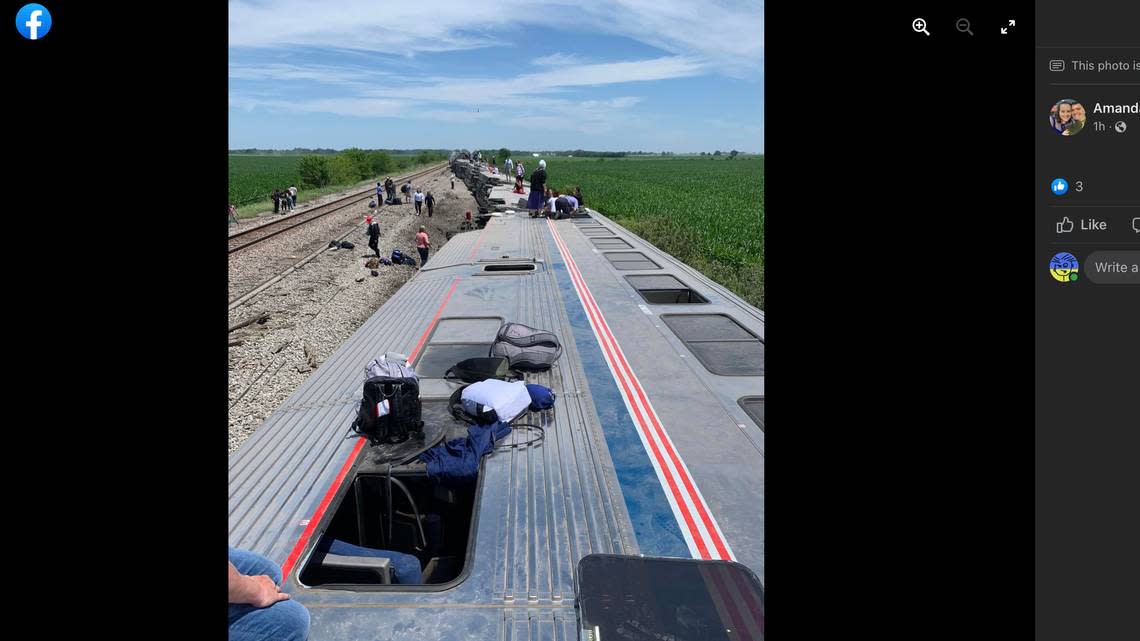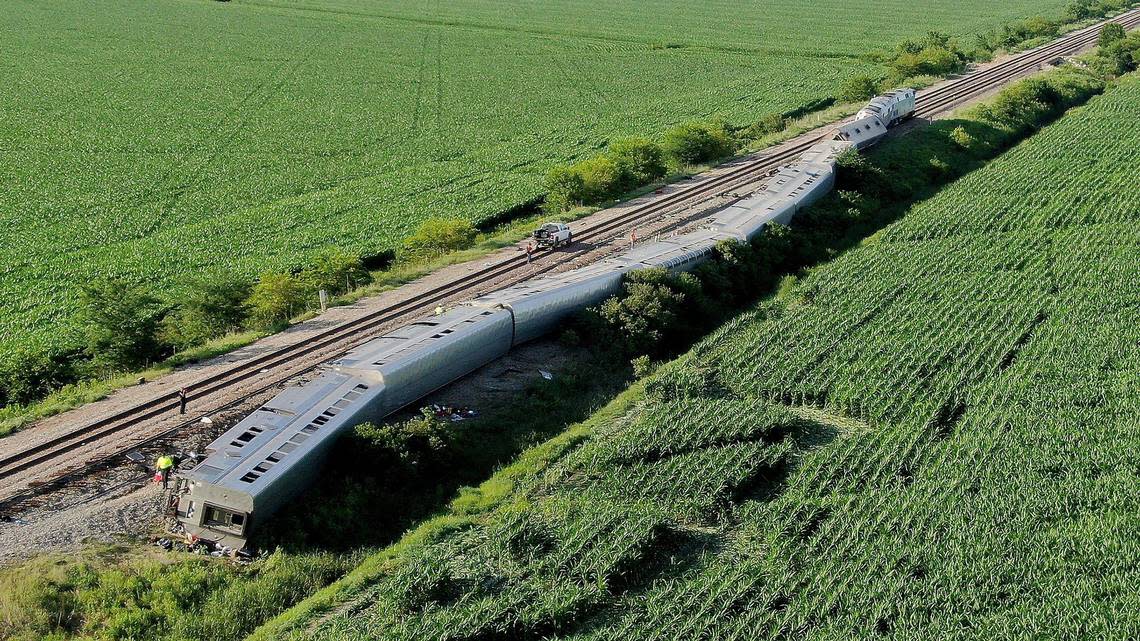Months after deadly Missouri train crash, survivor still deals with night terrors
The Mendon crash happened soon after midday. Rob Nightingale’s terrors would come at night.
On June 27, Nightingale was taking a catnap in his $400 sleeper berth, located four cars down from the locomotives, when he heard the Southwest Chief’s horn blast. An art gallery owner from Taos, he boarded the train in Lamy, New Mexico, not far from Sante Fe, only 24 hours before.
He prefers the train over planes. It offers him time to read, relax and, as he put it, “zone out.”
This year, as he does twice every year in the autumn and around July 4th, he was headed back to his native Chicago to spend two days with friends before getting on another train to Michigan to visit his brother and sister.
The horn sounded, rousing Nightingale, who had been in a fog, dozing and in and out of wakefulness. He’d brought a Vanity Fair magazine to read. At 1:30, he was due to be in the dining car for a lunch reservation.
The clock read 12:42 p.m.
“I remember just a boom, a bang, and the train shaking,” he said.
Nightingale, 57, was on the right side of the car.
“I looked out my window and all I could see was just brown dust — tons of dust — like the earth coming toward my window,” he recalled.
Is this F-ing happening? he remembered thinking.

The train rocked.
“I’m like, ‘Oh, my god!”
It began to tilt.
“We’re going over,” Nightingale said. “I know we’re starting to tip. And I’m freaking out because it is going over on my side.”
Instinctively, he shimmied up, clambering higher, as the train heaved and fell, fearing that as the weight of the train thundered onto the gravel, it would shatter the window on his side, and send up a fountain of glass and stone that would “just cut me up.”
Later he would discover that the train’s front locomotive, having smashed into the rear of a dump truck laden with stone, was still on the track, pulling and grinding his and the other toppled cars as they plowed up rock and dirt.
He recalled no alarms, no smells, but remembered that the train had just recently refueled. Would there be an explosion? All was silent.
“I sat there for a second digesting, ‘OK. I’m OK. Everything’s OK,’” he said.
His compartment door was now above his head. The glass window, unbroken, lay below him with his backpack and single suitcase. He grabbed his cell phone and his charger.
He grabbed his new laptop, too, taking it from his suitcase and shoving it into his backpack.
He hoisted himself up, opened his compartment door, and looked along the hallway to see passengers’ legs dangling in mid air as they, too, climbed up into the berths now at the top of the train. People released the windows and were climbing outside to the top of the train, now lying on its side.
“I got my cellphone out because I thought no one’s gonna effin believe what’s happening,” Nightingale said. “I couldn’t believe it, either.”
He shot some video, something he was accustomed to doing as a gallery owner, posting it to Facebook to show friends and family what was happening and so they’d know he was OK. The video went viral. Many people were grateful for the images.
Others later criticized him in comments.
“Some said, ‘How dare you videotape this trauma?’” Nightingale said. “Well, I was in shock, and I couldn’t believe what was going on.”
His most lasting image, he said, was arising from the train, looking outside and down the train’s long silver body stretched out on its side along a Missouri cornfield.
“It was surreal, like a movie,” he said.
The video captured his own voice. “It looks like we’re going to be late for Chicago.”
Then he sat. He cried. A mother and her two daughters sat near him.
“The little girl was crying, ‘We’re going to die. We’re going to die. The mother told her, ‘No, we’re OK. We’re all right.” He turned and told her the same.
More disturbing images are embedded in his own memory. A server from the dining car walking and covered in blood which, he assumed, was from helping others. Climbing down the train’s massive wheels, seeing people crying and hugging, seeing tires and debris from the dump truck, as he ambled back toward the crossing where the train and truck had crashed.
“When I got to the crossing, I saw what I thought was the wife of the truck driver running up to the scene, screaming, ‘I want to see him! I want to see him!’” Nightingale said. “They blocked her way and kept her back.”
The rest of the day became a swirl. A school bus back to the high school in Mendon. The Red Cross, water bottles, pizza, reporters, the kind townspeople, checking him, seeing if he was OK.
“I couldn’t say thank you because if I said thank you I knew I was going to start crying,” Nightingale said. “I just mouthed the words, ‘Thank you.’”

Late that night, he and other Southwest Chief passengers were given a two-hour van ride to a hotel in Quincy, Illinois, so they could grab a train onward to Chicago.
At 6 the next morning, they were all standing on the platform in Quincy. The train pulled in and hit its horn. Their nerves still on end, Nightingale said, everyone from the Southwest Chief jumped.
Several days later, he realized how deep a toll the accident took.
He was finally in Michigan. It was night. He was inside a guest room at his sister’s home.
“A big thunderstorm was coming off the lake in the middle of the night,” Nightingale said. “It was like lighting and — bam, bam, bam — consecutive, lightning and thunder.”
He felt trapped. Just as he did on the Southwest Chief, he grabbed his cell phone and charger.
“I ran into the door.
“Then, when I got back to Taos, I had a bizarre dream of being stuck in a room, and the room was getting smaller and smaller. I woke up and I jumped out of bed and I walked around. My heart was racing.”
Months have passed. Sleep still comes hard.
“I have anxiety,” he said. He has taken to sleeping with a light and television on, watching late-night Twilight Zone episodes on mute until he falls asleep.
Nightingale isn’t adverse to trains even now. On his return from Chicago, he again took the Southwest Chief.
Amtrak, he said, calls him at least monthly to check on how he is doing. People around town do, too, especially soon after the crash, telling him how glad they are that he is OK.
At first, Nightingale felt OK about it.
“They mean it in a caring way,” he said. But now he is glad that time is passing. Talking about the accident just brings it all back. He doesn’t want those images in his head.
“It’s just a constant reminder,” he said.
In October, he once again rode the Southwest Chief to Chicago. When he returned, people asked him how the trip was.
“I told them it was fine,” Nightingale said, “except I slept with my shoes and all my clothes on.”
